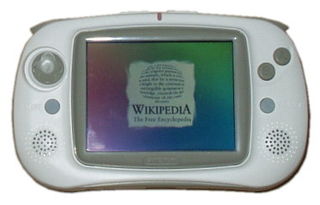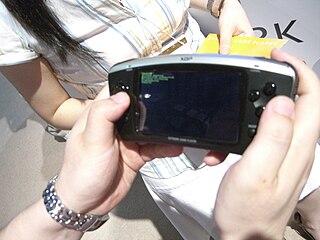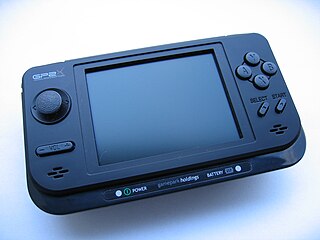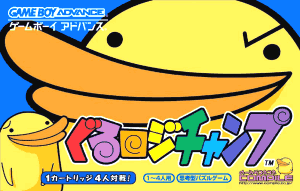Related Research Articles

Coleco Industries, Inc. was an American company founded in 1932 by Maurice Greenberg as The Connecticut Leather Company. It was a successful toy company in the 1980s, mass-producing versions of Cabbage Patch Kids dolls and its video game consoles, the Coleco Telstar dedicated consoles and ColecoVision. While the company ceased operations in 1988 as a result of bankruptcy, the Coleco brand was revived in 2005, and remains active to this day.

A handheld game console, or simply handheld console, is a small, portable self-contained video game console with a built-in screen, game controls and speakers. Handheld game consoles are smaller than home video game consoles and contain the console, screen, speakers, and controls in one unit, allowing players to carry them and play them at any time or place.

The GP32 is a handheld game console developed by the South Korean company Game Park. It was released on November 23, 2001, in South Korea and distributed in some parts of Europe.
Qt Extended is an application platform for embedded Linux-based mobile computing devices such as personal digital assistants, video projectors and mobile phones. It was initially developed by The Qt Company, at the time known as Qt Software and a subsidiary of Nokia. When they cancelled the project the free software portion of it was forked by the community and given the name Qt Extended Improved. The QtMoko Debian-based distribution is the natural successor to these projects as continued by the efforts of the Openmoko community.
Game Park was a South Korean company that was founded in 1996 and went bankrupt in March 2007. It is responsible for creating the GP32 and the never-released XGP. GamePark Holdings was founded by former employees of Game Park in 2005.
The history of video game consoles, both home and handheld, began in the 1970s. The first console that played games on a television set was the 1972 Magnavox Odyssey, first conceived by Ralph H. Baer in 1966. Handheld consoles originated from electro-mechanical games that used mechanical controls and light-emitting diodes (LED) as visual indicators. Handheld electronic games had replaced the mechanical controls with electronic and digital components, and with the introduction of Liquid-crystal display (LCD) to create video-like screens with programmable pixels, systems like the Microvision and the Game & Watch became the first handheld video game consoles.

A D-pad is a flat, typically thumb-operated, directional control. D-pads are found on nearly all modern gamepads, handheld game consoles, and audiovisual device remote controls. Because they operate using four internal push-buttons, the vast majority of D-pads provide discrete, rather than continuous, directional options—typically limited to up, down, left, and right, and sometimes offering intermediate diagonals by means of two-button combinations.

The XGP was a concept portable video game system created by the Korean company GamePark as the follow-up to its GP32 handheld. Initially announced in 2005, the XGP was finally announced in March 2006 along with the release of the similar XGP Mini and the XGP Kids. The company went bankrupt before releasing any of the models.

The GP2X is a Linux-based handheld video game console and portable media player developed by South Korean company GamePark Holdings. It was released on November 10, 2005, in South Korea only.

Guru Logi Champ is a puzzle game by the Japanese developer Compile. The game was released in 2001 for the Game Boy Advance handheld game system. "Guru Logi" is an abbreviation of "Guruguru Logic", "guruguru" (ぐるぐる) being a Japanese onomatopoeia for a rotating motion.
Wiz may refer to:

The Pandora is a handheld gaming computer originally released in 2010. It is designed to take advantage of existing free and open-source software and to be a target for homebrew development. It is developed and produced by OpenPandora, which is made up of former distributors and community members of the GP32 and GP2X handhelds. Until 2013, multiple batches of slightly updated Pandora variants were produced. In 2014 the development of a redesigned and upgraded successor, called DragonBox Pyra, was started.

The GP2X Wiz is a handheld game console and portable media player developed by South Korean company GamePark Holdings running a Linux kernel-based embedded operating system.

The Dingoo is a handheld gaming console that supports music and video playback and open game development. The system features an on-board radio and recording program. It was sold to consumers in three colors: white, black, and pink. It was released in February 2009 and had sold over 1 million units.
BennuGD is a high-level open-source video game development suite, originally created as a Fenix Project fork by Argentinian hacker SpliterGU. It is officially supported for Windows, Linux, GP2X Wiz, GP2X Caanoo and Dingux, but can also be run on multiple other platforms to some extent, including FreeBSD, Mac OS X, iOS, and consoles such as GP2X, Dingoo A320, and Wii. Most recently BennuGD has been ported to Sega Dreamcast and PlayStation 2.

The GP2X Caanoo, more commonly known as Caanoo, stylized CAANOO, is an open source, Linux-based handheld video game console and portable media player developed by the South Korean company GamePark Holdings. It was released on August 16, 2010 in South Korea and was also sold throughout Europe. It is the successor to the GP2X Wiz, and was showcased at the Electronic Entertainment Expo 2010. The device's launch price was about US$150, which didn't reach any retail stores in North America.

The Game Gadget is an open source gaming handheld that supports music and video playback, open game development, and some e-reader features.

The DragonBox Pyra is an upcoming Linux-based handheld computer equipped with a keyboard and gaming controls. The project entered prototyping stage in 2015. Pre-orders began on 1 May 2016, with a final release date still undefined. In August 2020 the first production model had been shipped, but only to developers, as the software wasn't ready.

The GCW Zero is a Linux-based open-source handheld video game console created by a start up, Game Consoles Worldwide. The GCW Zero was funded by a successful crowdfunding campaign on kickstarter.com on 29 January 2013 with US$238,499 collected, originally aiming for $130,000. The project was created by Justin Barwick. The device was eventually released that year.
References
- ↑ "GPH". Archived from the original on 2011-03-13. Retrieved 2010-11-14.
- ↑ "GPH". Archived from the original on 2011-03-13. Retrieved 2010-11-14.
- ↑ Revenue Taxation type/closed business results